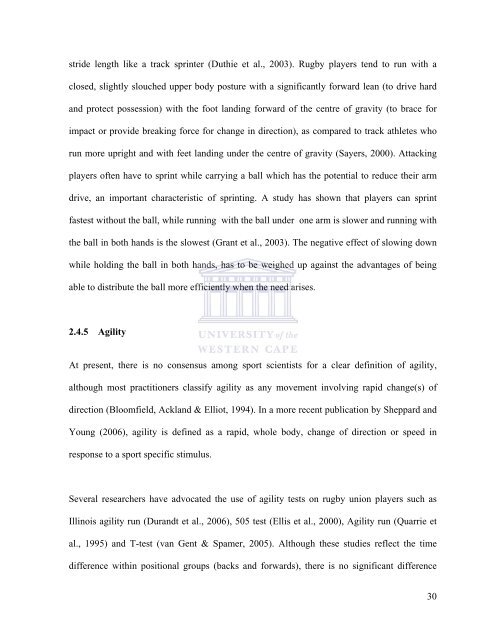Physical fitness of elite women's rugby union players over a ...
Physical fitness of elite women's rugby union players over a ...
Physical fitness of elite women's rugby union players over a ...
You also want an ePaper? Increase the reach of your titles
YUMPU automatically turns print PDFs into web optimized ePapers that Google loves.
stride length like a track sprinter (Duthie et al., 2003). Rugby <strong>players</strong> tend to run with a<br />
closed, slightly slouched upper body posture with a significantly forward lean (to drive hard<br />
and protect possession) with the foot landing forward <strong>of</strong> the centre <strong>of</strong> gravity (to brace for<br />
impact or provide breaking force for change in direction), as compared to track athletes who<br />
run more upright and with feet landing under the centre <strong>of</strong> gravity (Sayers, 2000). Attacking<br />
<strong>players</strong> <strong>of</strong>ten have to sprint while carrying a ball which has the potential to reduce their arm<br />
drive, an important characteristic <strong>of</strong> sprinting. A study has shown that <strong>players</strong> can sprint<br />
fastest without the ball, while running with the ball under one arm is slower and running with<br />
the ball in both hands is the slowest (Grant et al., 2003). The negative effect <strong>of</strong> slowing down<br />
while holding the ball in both hands, has to be weighed up against the advantages <strong>of</strong> being<br />
able to distribute the ball more efficiently when the need arises.<br />
2.4.5 Agility<br />
At present, there is no consensus among sport scientists for a clear definition <strong>of</strong> agility,<br />
although most practitioners classify agility as any movement involving rapid change(s) <strong>of</strong><br />
direction (Bloomfield, Ackland & Elliot, 1994). In a more recent publication by Sheppard and<br />
Young (2006), agility is defined as a rapid, whole body, change <strong>of</strong> direction or speed in<br />
response to a sport specific stimulus.<br />
Several researchers have advocated the use <strong>of</strong> agility tests on <strong>rugby</strong> <strong>union</strong> <strong>players</strong> such as<br />
Illinois agility run (Durandt et al., 2006), 505 test (Ellis et al., 2000), Agility run (Quarrie et<br />
al., 1995) and T-test (van Gent & Spamer, 2005). Although these studies reflect the time<br />
difference within positional groups (backs and forwards), there is no significant difference<br />
30
















